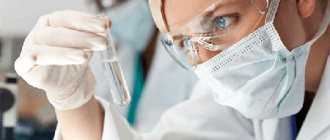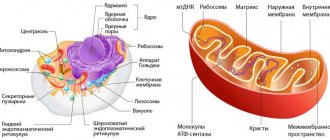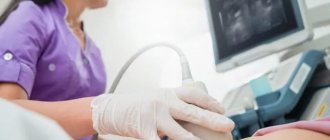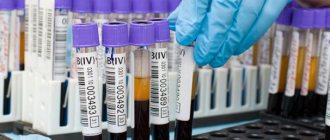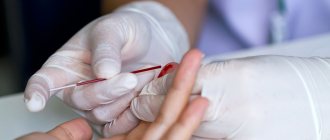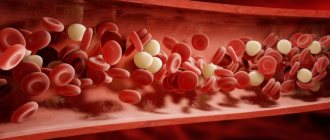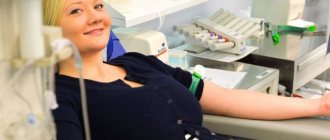The level of antibodies to the thyroglobulin protein is normally insignificant, since they are formed as a reaction of the body’s immune system to contact with thyroglobulin. Typically, this colloidal protein is located in the enclosed space of the follicle and does not provoke the formation of antibodies. The reason for exceeding the norm for antibodies to thyroglobulin may be damage to the follicle and the release of a significant amount of thyroglobulin into the blood. Then, in the results of tests for antibodies to thyroglobulin, increased values are recorded.
Diseases of the thyroid gland that require testing for elevated thyroglobulin
An analysis for elevated thyroglobulin is done in the following cases:
• For thyroid carcinoma. But it should be remembered that only a third of patients with thyroid cancer have an increase in the concentration of this protein;
• For the purpose of early detection of metastases or relapses of tumors after surgical treatment has already been performed. A relapse of both malignant and benign thyroid tumors may be indicated by increased thyroglobulin in the blood plasma;
• Determination of the effectiveness of radioactive iodine therapy for the metastatic process in thyroid tumors;
• For the diagnosis of artificial thyrotoxicosis (against the background of hormone replacement treatment);
• Thyroglobulin, the norm of which is increased, is assessed in children to determine the origin of congenital hyperfunction of the thyroid gland;
• As a tumor marker and a means for assessing the effectiveness of treatment of thyroid tumors;
• To assess the activity of thyroiditis or confirm previous inflammation of the thyroid gland in the next 2 years;
• For mass studies in conditions of iodine deficiency.
Thyroglobulin is a prohormone of the thyroid gland, which is a marker of relapse of well-differentiated malignant neoplasms of the thyroid gland and is used to monitor the treatment of these diseases.
Synonyms Russian
TG.
English synonyms
Thyroglobulin (Tg).
Research method
Solid-phase chemiluminescent enzyme-linked immunosorbent assay (“sandwich” method).
Units
ng/ml (nanograms per milliliter).
What biomaterial can be used for research?
Venous blood.
How to properly prepare for research?
- Do not eat for 2-3 hours before the test; you can drink clean still water.
- Avoid physical and emotional stress 30 minutes before the test.
- Do not smoke for 30 minutes before the test.
General information about the study
Thyroglobulin is a large glycoprotein (molecular weight 660 kDa) stored in the colloid of thyroid follicles. This is a prohormone necessary for the further synthesis of thyroxine (T4) and triiodothyronine (T3). The thyroid gland is the only source of thyroglobulin in the body. Its production occurs in the cells of the normal thyroid gland, as well as in the cells of highly differentiated malignant neoplasms of this organ (papillary and follicular adenocarcinoma). Determining the concentration of thyroglobulin in the blood is used to monitor treatment and timely diagnose the recurrence of these thyroid tumors.
A feature of well-differentiated thyroid cancers is their relatively favorable prognosis with timely diagnosis of the disease, as well as careful monitoring in the postoperative period. About 85% of patients fully recover after treatment, 15% experience cancer recurrence, and 5% of these have a progressive and severe recurrence. Therefore, for laboratory diagnosis of cancer recurrence, a method is needed that, on the one hand, has a high negative predictive value, which will avoid unnecessary diagnostic procedures in the vast majority of patients, and, on the other hand, a high positive predictive value, which will allow one to suspect the occurrence of a relapse in some patients. early stage. The main laboratory marker of tumor recurrence that meets these conditions is the detection of thyroglobulin in the blood.
Typically, thyroglobulin testing is performed 6-12 months after total thyroidectomy and radioablation. Since during this entire period the patient receives L-thyroxine replacement therapy, the first measurement of thyroglobulin level is made against the background of suppression of the patient's own thyroid stimulating hormone (TSH, TSH-suppressed TG). As a rule, after receiving the test result against the background of replacement therapy, a provocative test is performed using exogenous TSH (TSH-stimulated TG). The sensitivity of thyroglobulin testing after this test is higher than when measuring basal thyroglobulin levels. It has been shown that in 15-20% of patients with a negative test result for basal thyroglobulin during replacement therapy, an increased level of this hormone is detected after the administration of TSH.
The study is characterized by high specificity and sensitivity, but has some limitations. The presence of antibodies to thyroglobulin in the blood (found in 20% of patients with thyroid cancer) interferes with the reaction and can lead to a false negative result. Therefore, when performing a thyroglobulin test, the presence of antibodies to thyroglobulin in the blood is simultaneously assessed. It is believed that if they are available, research using chemiluminescence immunoassay is inferior in sensitivity to radioimmunoassay. In addition to specific antibodies, other (heterophilic) antibodies observed in cytomegalovirus infection, toxoplasmosis and infectious mononucleosis can also interfere with the reaction. A false negative result is possible with a very small tumor. Also, the result will be negative when examining the blood of a patient with a recurrent tumor that secretes defective thyroglobulin or does not produce this hormone at all. Taking these rare exceptions into account, we can conclude that an undetectable level of thyroglobulin after a provocative test with TSH (in the absence of antibodies to thyroglobulin) corresponds to a 98-99.5% probability of no tumor recurrence in the future. It should be noted that the result of the analysis is assessed in conjunction with clinical and instrumental data.
Patients with a high risk of tumor recurrence undergo repeated (multiple) studies of thyroglobulin levels after a provocative test with an interval of 6 months, patients with a low risk of tumor recurrence - with an interval of 12 months, there is no need for a provocative test, the study can be carried out against the background of replacement therapy . The advisability of further monitoring is determined by the doctor; in each case, its duration is determined individually. Given the need to compare test results, it is recommended that the test be performed in the same laboratory.
What is the research used for?
To monitor treatment and timely detect relapse of papillary and follicular adenocarcinoma of the thyroid gland.
When is the study scheduled?
- All patients 6-12 months after thyroidectomy;
- for patients with a high risk of relapse - regularly every 6 months;
- for patients with a low risk of relapse - regularly every 12 months.
What do the results mean?
Reference values: 1.4 - 78 ng/ml.
Reasons for the positive result:
- recurrence of thyroid cancer.
Reasons for negative results:
- recovery.
What can influence the result?
- The presence in the serum of specific antibodies to thyroglobulin, as well as heterophilic antibodies (with cytomegalovirus infection, infectious mononucleosis and toxoplasmosis) can lead to a false negative result.
When are antibodies to thyroglobulin elevated?
• If antibodies to thyroid peroxidase and thyroglobulin are elevated, Hashimoto's chronic thyroiditis may be the cause.
• Antibodies to thyroglobulin are elevated during autoimmune inflammation of the gland tissue - thyroiditis.
• Hypothyroidism without a clearly identified cause, or idiopathic hypothyroidism, can also be manifested by increased antibodies in the blood.
• Antibodies to thyroglobulin can also be elevated in diffuse toxic goiter (Graves' disease).
References
- Histology (introduction to pathology) / ed. E.G. Ulumbekova, Yu.A. Chelysheva, 1997. - P. 147-163.
- Clinical guidelines for thyroid cancer - approved. Ministry of Health of Russia, 2021. - 47 p.
- Oncology / ed. acad. RAMS V.I. Chissova and prof. S.L. Daryalova, 2007. - pp. 83-99.
- Arthur, C., Hall, J. Textbook of Medical Physiology. 13th Edition, 2015. - P. 1042-1055.
- Kumar, V., Abbas, A., Fausto, N. et al. Robbins and Cotran Pathologic Basis of Disease, 2014. - 1464 p.
And the most important…
At the end of this short article, I would like to say that thyroglobulin is a highly specialized laboratory indicator that is used only in some selected situations. It should be used only for its intended purpose and not used where you can do without it. Elevated thyroglobulin
Blood tests aimlessly scare thousands of people every year, but for thousands of people every year,
the thyroglobulin level
gives hope for a normal life - it’s all just a matter of who prescribes the test, in what situations and how the results are then interpreted. The 3rd generation immunochemiluminescent laboratory of the Northwestern Endocrinology Center determines thyroglobulin with extreme accuracy, and the center’s specialists know very, very much about it, so if you suddenly have any questions or misunderstanding of your tests or your doctor’s tactics, come to us to the center for a consultation or re-analysis in order to remove all questions and understand how and where to move on.
Preparing the patient for the procedure and features of blood donation
In order for the research results to be accurate and reliable, simple rules should be followed. The patient can take a TG test 3 months after the end of surgical treatment. If a person was treated with radioactive iodine, he should wait at least six months to donate blood. If these deadlines are not met, the results of the study will be incorrect and there is a possibility that the possibility of relapse will be shown when in fact the harmful tumor does not develop.
When determining the level of iodine globulin, a test is carried out for antibodies to the protein. If a large number of antibodies are detected, the hormone level will be considered quite low. After stopping thyroxine for several weeks, the effectiveness of the manipulation will become more reliable, but the doctor must make sure that the patient does not have antibodies to the test hormone using special tests and diagnostics.
In order for the results of the study to be without distortion, blood should be donated on an empty stomach in the morning. 24 hours before the procedure, the patient should not engage in sports; 1.5-2 months before the procedure, it is prohibited to use medications containing iodine and hormones.
The manipulation is carried out in the treatment room. The patient sits on the couch and the nurse examines the veins in his arms. The patient's forearm is clamped with a special tourniquet, and the place where the needle will be inserted is lubricated with a cotton pad previously soaked in ethyl alcohol. The specialist pierces the vein with a hollow needle and begins collecting the biomaterial into a flask or other sterile container.
The resulting sample is placed in a test tube and a smear is made on the glass. The biomaterial can be sent to the laboratory, and the patient applies cotton wool with alcohol to the injection site and fixes it with a bandage on top. The patient should hold his hand tightly and not move it for 5 to 10 minutes to avoid bleeding and bruises on the skin.
When is a blood test for hormones prescribed?
Hormonal analysis is usually carried out if there is a suspicion of dysfunction of the endocrine glands or if an increase in the size of the glands is detected.
Indications for testing for female sex hormones (estrogens)
are:
- menstrual irregularities;
- infertility;
- miscarriage;
- acne;
- overweight;
- fibrocystic mastopathy (breast disease).
Indications for testing for male sex hormones (androgens)
are:
- suspicion of the development of tumor processes;
- ovarian dysfunction;
- kidney dysfunction;
- overweight (obesity);
- infertility;
- acne;
- in women – excessive growth of body hair.
Hormonal analysis is prescribed during pregnancy if pathological development of the fetus is suspected. An analysis for the hormone hCG (human chorionic gonadotropin), produced by the cells of the membrane of the embryo, can detect pregnancy already on the 6-10th day after fertilization.
Indications and contraindications
There is no danger for the manipulation, since the nurse draws blood from the patient with a disposable syringe.
The procedure lasts about one minute and is considered virtually painless. After taking a blood sample, the person must sit on the couch for a couple of minutes before going home.
Indications for analysis are:
- congenital hypothyroidism in young children;
- assessment of the patient’s iodine deficiency status;
- diagnosis of artificial thyrotoxicosis;
- control over the treatment of various types of thyroid carcinomas;
- thyroiditis.
As a rule, there are no side effects or complications after blood sampling in patients.
Thyroglobulin - what is it?
It is a protein that is a precursor to thyroid hormones in the human body.
The synthesis of thyroid hormones T3 and T4 in the human body does not occur immediately, but through the formation of thyroglobulin. This complex protein consists of amino acid residues tyrosine and iodine. In fact, thyroglobulin is a chain of almost ready-made molecules of the hormone thyroxine (T4), which only needs to be “cut” before the hormone is released into the blood. The protein is stored in the lumen of the thyroid follicles as a kind of “reserve”. The cells of the gland form single-layer spherical clusters, the internal lumen of which is filled with a viscous transparent gel - a colloid containing a large amount of thyroglobulin. It is stored in the lumen of the follicle until it is required by the body - then its molecule is captured by thyrocytes (thyroid cells) and passed through them, cutting into residues of two tyrosine molecules and four iodine atoms in each residue. Such “chopped” thyroglobulin is nothing more than a ready-made molecule of the main thyroid hormone, thyroxine, which is released into the blood.
